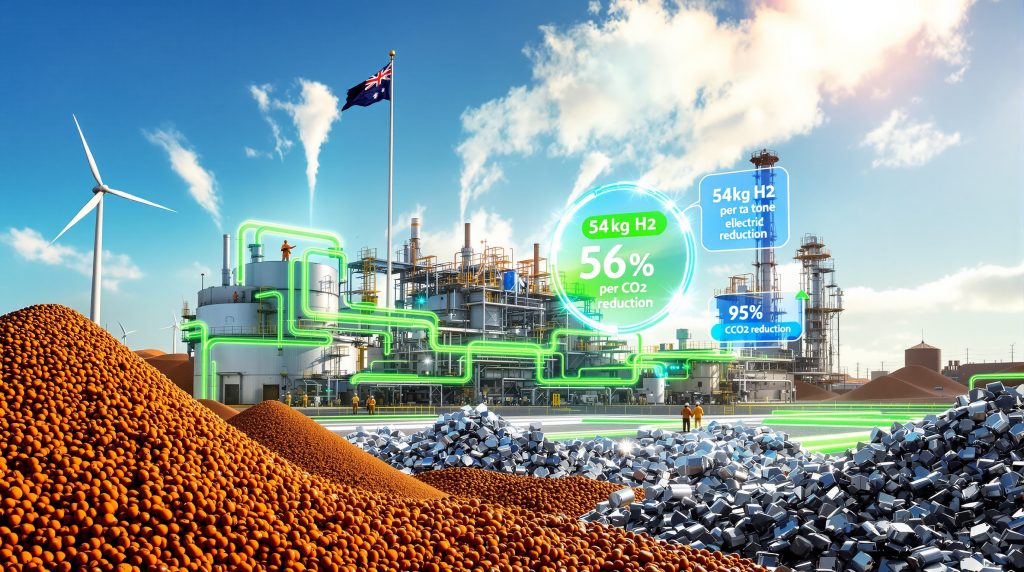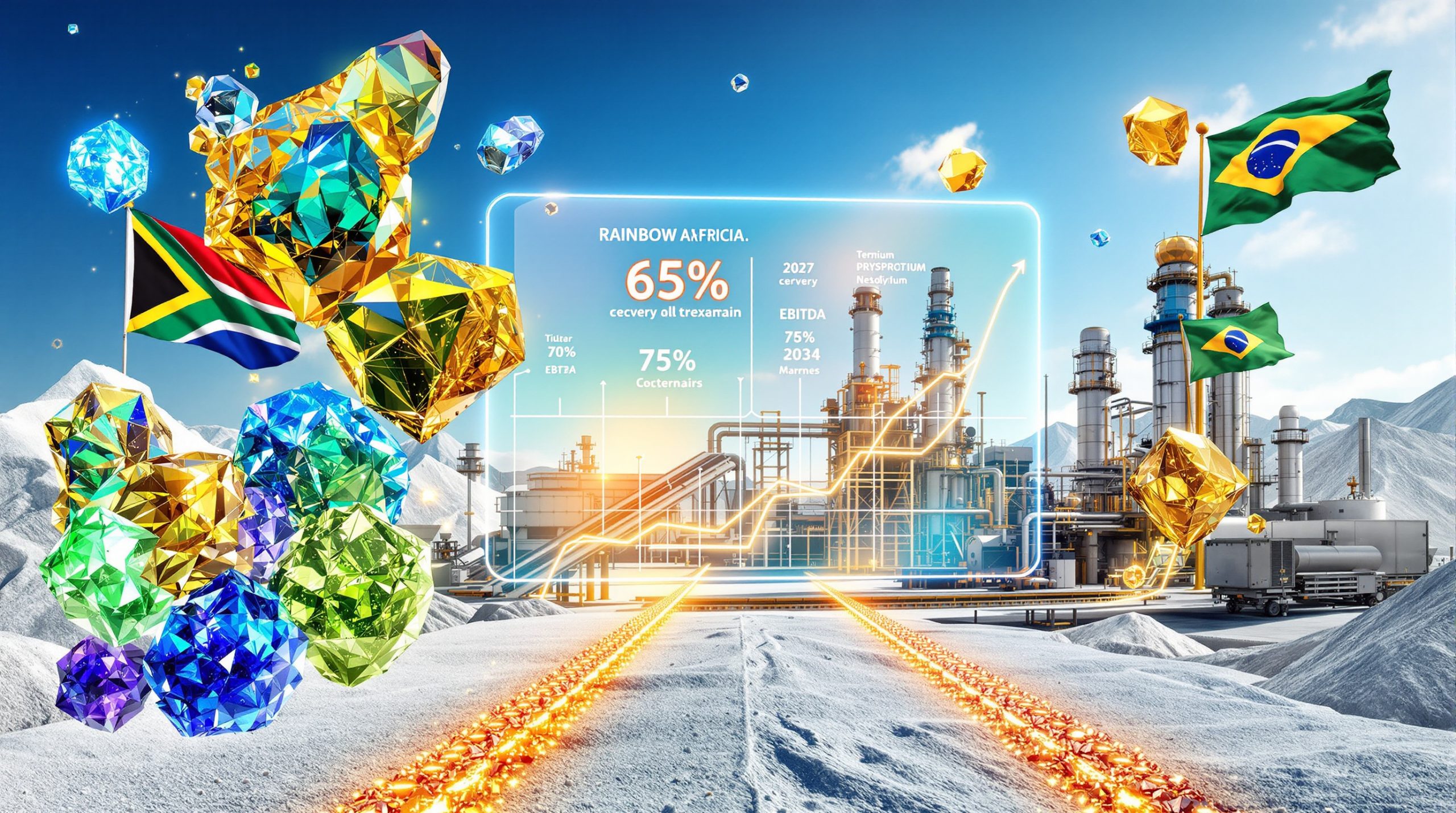The steel industry faces unprecedented pressure to decarbonize as global markets demand sustainable production methods. Zesty green iron represents a revolutionary technological breakthrough that addresses these challenges through innovative hydrogen-based reduction processes powered entirely by renewable energy. This groundbreaking technology demonstrates how industry innovation trends can transform one of the world's most carbon-intensive industries.
The Zero Emissions Steel Technology process eliminates traditional fossil fuel combustion entirely, replacing coal-fired systems with electric heating mechanisms powered by renewable energy sources. This technological shift addresses one of the most carbon-intensive industrial processes globally, offering steelmakers a viable pathway toward decarbonization without compromising production efficiency.
Unlike conventional blast furnace operations that require specific ore grades and extensive preprocessing, zesty green iron technology demonstrates remarkable flexibility in feedstock utilization. The process can handle lower-grade iron ore fines directly, eliminating costly pelletization steps while converting previously unusable mining waste into valuable production inputs.
Revolutionary Hydrogen Efficiency in Steel Manufacturing
The hydrogen optimization achieved by ZESTY technology represents a significant breakthrough in sustainable metallurgy. The process consumes approximately 54 kilograms of hydrogen per tonne of iron produced, delivering a substantial 50% reduction compared to conventional hydrogen-based reduction methods currently being developed worldwide.
This efficiency gain stems from advanced process engineering that maximizes hydrogen utilization through:
• Optimized reaction kinetics that ensure complete iron oxide reduction
• Enhanced gas circulation systems that minimize hydrogen waste
• Temperature control precision that maintains optimal reduction conditions
• Integrated hydrogen recovery mechanisms that recycle unused gas streams
According to the International Energy Agency, steel production technologies like ZESTY have the potential to help decarbonize a critical industry responsible for approximately 8% of total global carbon dioxide emissions. Furthermore, these developments align with broader energy transition strategies being implemented across the resources sector.
Renewable Energy Integration Framework
The ZESTY process achieves zero combustion emissions through comprehensive renewable energy integration across all operational components. Electric heating systems replace traditional coal-fired furnaces, while green hydrogen production relies entirely on renewable electricity sources such as solar and wind power.
| Process Component | Energy Requirement (MWh/tonne) |
|---|---|
| Total Energy Consumption | 4.2-4.6 |
| Green Hydrogen Production | 2.9-3.3 |
| Direct Process Energy | 0.9-1.3 |
| Auxiliary Systems | 0.4-1.0 |
The circular hydrogen utilisation system incorporated within ZESTY technology captures and recycles hydrogen that would otherwise be lost during the reduction process. This advanced recycling capability contributes significantly to the overall efficiency improvements and cost reductions compared to traditional hydrogen-based iron production methods.
Distinctive Advantages Over Traditional Ironmaking Methods
Traditional blast furnace operations require high-grade pelletised iron ore, creating significant preprocessing costs and limiting feedstock flexibility. ZESTY technology fundamentally changes this dynamic by processing diverse ore types without pelletisation requirements.
Ore Processing Flexibility
The technology enables processing of materials traditionally considered waste or economically unviable:
• Lower-grade iron ore fines without quality upgrading requirements
• Mining waste products such as slimes and processing residues
• Diverse ore compositions from multiple geographic sources
• Previously discarded materials that can now generate revenue streams
Matthew Holcz, Rio Tinto Iron Ore Chief Executive, emphasised that the company continues to look at various ways Pilbara iron ores can contribute to decarbonisation as new technologies emerge. In addition, this flexibility aligns with innovative waste valorisation strategies being developed across the mining sector.
Economic Benefits of Waste Material Valorisation
The ability to convert mining waste into valuable feedstock creates multiple economic advantages for mining operators. Traditional iron ore operations generate substantial volumes of fines and processing residues that require costly disposal or storage management.
Zesty green iron technology transforms these liability streams into revenue-generating assets, improving overall mine economics while reducing environmental footprint. Consequently, the elimination of pelletisation requirements also removes energy-intensive preprocessing steps, further reducing both costs and emissions.
ZESTY Demonstration Plant Development Strategy
The 30,000 tonnes per annum demonstration facility located in Kwinana, Western Australia, represents a critical milestone for validating commercial viability. This pilot-scale operation enables comprehensive testing under real-world industrial conditions while establishing the technical and economic foundations for future commercial deployment.
Strategic Location Advantages
The Kwinana site provides essential infrastructure benefits that support both demonstration and future commercial operations:
• Established port access for efficient raw material delivery and product distribution
• Proximity to NeoSmelt downstream processing facilities enabling integrated value chains
• Existing industrial networks providing utilities and support services
• Renewable energy grid connectivity ensuring sustainable power supply
Phil Hodgson, Calix Chief Executive, described the joint development agreement with Rio Tinto as a major milestone in the commercialisation of ZESTY, providing cash and hands-on support including industry-leading resources, expertise, and market reach to progress the demonstration project. Furthermore, these developments showcase the type of innovation expo insights that are transforming the mining industry.
Comprehensive Testing Protocol
The demonstration plant enables systematic validation across multiple operational parameters:
-
Diverse ore composition testing using various Pilbara iron ore types
-
Economic performance validation under realistic industrial operating conditions
-
Technology optimisation for improved efficiency and reliability
-
Product quality demonstration meeting steel industry specifications
-
Market acceptance verification through customer engagement programmes
According to the Australian Renewable Energy Agency, Rio Tinto committed to supplying up to 10,000 tonnes of various Pilbara iron ores for plant commissioning and initial testing phases, subject to final investment decision and successful project construction.
Economic Implications and Investment Structure
The financial commitment to ZESTY technology demonstrates strong industry confidence in green iron commercialisation potential. The combined $79.9 million investment includes $35 million from Rio Tinto and $44.9 million from ARENA (Australian Renewable Energy Agency).
"The substantial funding commitment from both industry and government sources reflects recognition that green iron technology represents a critical pathway for steel industry decarbonisation while maintaining economic competitiveness."
Technology Licensing and Revenue Potential
The partnership agreement enables Rio Tinto to exercise a non-exclusive global and perpetual licence for potential commercial use of ZESTY technology. This licensing framework creates multiple revenue streams for technology deployment:
• Direct licensing fees from steel producers adopting the technology
• Toll processing revenues from ore suppliers utilising ZESTY facilities
• Technical service income from ongoing support and optimisation
• Equipment supply opportunities through modular facility construction
The modular scalability inherent in ZESTY design enables linear capacity expansion through unit duplication, reducing capital risk while providing flexible deployment options for different market conditions and customer requirements.
Market Premium Positioning
Green iron products command premium pricing in steel markets increasingly focused on decarbonisation. Steel producers face mounting pressure from automotive, construction, and manufacturing customers demanding verified low-carbon materials.
However, ZESTY technology enables steel producers to access these premium markets while maintaining cost competitiveness through improved hydrogen efficiency and reduced operational complexity compared to alternative green steel technologies.
Supporting Australian Mining Industry Competitiveness
Australia's position as the world's largest iron ore exporter faces potential challenges as global steel markets increasingly prioritise decarbonisation. Zesty green iron technology positions Australian iron ore producers to maintain competitive advantages in this evolving market landscape.
Pilbara Iron Ore Utilisation Strategy
The technology enables Australian mining companies to:
• Access premium markets demanding verified low-carbon steel inputs
• Process lower-grade reserves previously considered economically marginal
• Maintain competitive positioning as global steel producers adopt green technologies
• Develop additional revenue streams from previously discarded waste materials
For instance, these developments complement broader sustainability transformation projects being implemented across the Australian resources sector.
Supply Chain Integration Benefits
ZESTY produces direct reduced iron (DRI) compatible with electric arc furnace steelmaking infrastructure, which represents approximately 30-40% of global steel production capacity. This compatibility ensures broad market acceptance and integration opportunities.
The technology also reduces transportation emissions through local processing, converting raw ore into higher-value DRI products closer to mining operations. This approach minimises shipping costs while reducing the carbon footprint associated with bulk commodity transportation.
According to the Calix global website, Rio Tinto committed to providing introductions to potential customers for downstream use of ZESTY products, leveraging the company's global market relationships to accelerate commercial adoption.
Global Steel Industry Decarbonisation Challenge
Traditional steelmaking accounts for approximately 8% of global CO2 emissions, according to International Energy Agency data. This massive emissions footprint creates urgent demand for viable decarbonisation technologies that can operate at industrial scale.
ZESTY Environmental Impact
The technology addresses climate change challenges through multiple mechanisms:
• 95% emission reduction compared to conventional blast furnace methods
• Complete elimination of fossil fuel combustion during iron reduction
• Renewable energy dependency eliminating ongoing carbon emissions
• Hydrogen efficiency improvements reducing overall energy requirements
Technical Risk Mitigation Approach
The demonstration phase focuses on systematic risk reduction across critical operational parameters:
-
Process optimisation for handling various ore compositions and qualities
-
Equipment reliability validation under continuous industrial operating conditions
-
Product quality consistency ensuring compliance with steel industry specifications
-
Economic viability confirmation across different market scenarios and commodity prices
The comprehensive testing approach provides confidence for future commercial-scale deployment while identifying potential optimisation opportunities that could further improve economic and environmental performance.
Government Policy Support Framework
Western Australian government initiatives demonstrate strong policy support for green steel development. Recent procurement policies prioritise locally-produced green steel for major infrastructure projects, creating immediate market demand for ZESTY technology output.
Strategic Procurement Initiatives
WA Premier Roger Cook indicated that locally made green iron represents a key component in making Western Australia a renewable energy powerhouse. The government has adopted an "if not, why not" approach to green steel procurement on major government projects.
This procurement strategy creates immediate market demand while supporting industrial development and job creation in sustainable manufacturing sectors. The policy framework reduces commercial risk for green iron investments by providing guaranteed offtake opportunities.
National Energy Transition Support
Federal government support through ARENA funding demonstrates national commitment to green steel technology development. The $44.9 million ARENA contribution represents substantial public investment in industrial decarbonisation technologies.
Additional federal initiatives include:
• Renewable energy infrastructure development supporting green hydrogen production
• Research and development partnerships with universities and technology companies
• International collaboration programmes sharing green steel technology developments
• Industrial transition support for communities dependent on traditional heavy industry
Future Commercial Deployment Prospects
Successful demonstration will enable rapid commercial scale-up across multiple deployment scenarios. The modular design philosophy inherent in ZESTY technology supports flexible implementation strategies adapted to different market conditions and customer requirements.
Scale-Up Implementation Strategy
Commercial deployment opportunities include:
• Industrial-scale facilities serving regional steel production markets
• Technology licensing programmes enabling global adoption by steel producers
• Export market development for Australian green iron products
• Supply chain transformation throughout the global steel industry ecosystem
Market Impact Projections
The technology creates multiple value propositions for different market participants:
| Market Segment | Primary Benefits |
|---|---|
| Steel Producers | Reduced emissions, premium pricing access |
| Mining Companies | Waste valorisation, lower-grade ore utilisation |
| Governments | Industrial job creation, emissions reduction |
| End Users | Verified low-carbon steel products |
Disclaimer: Market impact projections are based on current industry trends and successful technology demonstration. Actual outcomes may vary depending on regulatory changes, commodity prices, and competitive technology developments.
Technology Integration with Existing Infrastructure
ZESTY technology demonstrates remarkable compatibility with existing steel production infrastructure, reducing barriers to adoption and implementation costs for steel producers. The direct reduced iron output integrates seamlessly with electric arc furnace operations without requiring substantial facility modifications.
Electric Arc Furnace Compatibility
The DRI produced by ZESTY technology meets specifications required for electric arc furnace steelmaking, which represents the fastest-growing segment of global steel production. This compatibility enables:
• Immediate market penetration through existing customer relationships
• Reduced capital requirements for steel producers adopting green feedstocks
• Operational continuity during transition from traditional to green iron sources
• Quality consistency meeting demanding steel grade specifications
NeoSmelt Integration Opportunities
The strategic location near NeoSmelt downstream processing facilities provides additional value chain integration possibilities. Rio Tinto participates in the five-company NeoSmelt project, which secured ARENA funding for advanced steel processing technologies.
This proximity enables potential integration of zesty green iron production with advanced downstream processing capabilities, creating comprehensive value chains from raw ore through finished steel products.
Industry Expert Perspectives on Green Iron Development
Industry leadership recognition of ZESTY technology importance extends beyond financial investment to strategic positioning for long-term competitiveness. Matthew Holcz of Rio Tinto emphasised that both ZESTY and BioIron projects represent part of the company's work to reduce emissions and support the future of iron ore in Australia and the communities that depend on it.
Technology Risk Assessment
Rio Tinto's evaluation process demonstrates rigorous technical assessment standards applied to emerging technologies. The company determined that current furnace design for BioIron requires additional development to minimise technical risks and optimise performance, highlighting the comprehensive due diligence applied to green steel investments.
This thorough risk assessment approach provides confidence in ZESTY technology selection, as it survived the same rigorous evaluation process that identified areas for improvement in alternative approaches.
Scope 3 Emissions Context
According to industry reports, steelmaking accounted for 69% of Rio Tinto's Scope 3 emissions in 2023. This substantial emissions footprint demonstrates the strategic importance of green steel technologies for major mining companies addressing climate change commitments.
The focus on Scope 3 emissions reflects growing recognition that mining companies must address downstream impacts of their products, not just direct operational emissions. ZESTY technology provides a viable pathway for reducing these indirect emissions while maintaining business competitiveness.
Frequently Asked Questions About Zesty Green Iron
What distinguishes zesty green iron from traditional iron production?
Zesty green iron utilises renewable electricity and hydrogen reduction instead of coal-based blast furnace methods, eliminating fossil fuel combustion while achieving up to 95% emission reductions compared to conventional steelmaking processes.
How much hydrogen does ZESTY technology require for operation?
The process consumes approximately 54 kilograms of hydrogen per tonne of iron produced, representing a 50% reduction compared to other hydrogen-based iron reduction technologies currently under development globally.
Can ZESTY process different iron ore grades and types?
Yes, the technology demonstrates remarkable feedstock flexibility, processing lower-grade iron ore fines without pelletisation requirements and converting previously unusable mining waste materials into valuable production inputs.
When might commercial-scale ZESTY facilities become operational?
Following successful demonstration plant validation, commercial deployment could commence within 5-7 years, subject to final investment decisions, market conditions, and regulatory approvals for large-scale facilities.
What role does government policy play in green iron development?
Government support includes direct funding through ARENA, procurement preferences for major infrastructure projects, and renewable energy infrastructure development that enables cost-effective green hydrogen production essential for ZESTY operations.
Key Insights: The Green Iron Technology Revolution
Zesty green iron technology represents a transformative approach to sustainable metallurgy, providing the steel industry with a technically and economically viable decarbonisation pathway. Through innovative hydrogen efficiency optimisation, renewable energy integration, and unprecedented ore processing flexibility, ZESTY positions Australia as a global leader in clean steel production technology.
The combination of substantial industry and government investment, demonstrated technical capabilities, and strong policy support creates favourable conditions for successful commercial deployment. However, the technology's modular scalability and infrastructure compatibility reduce implementation risks while providing flexible adaptation to diverse market requirements.
Most significantly, ZESTY technology addresses the fundamental challenge facing the steel industry: achieving substantial emission reductions while maintaining cost competitiveness and operational reliability. The 95% emission reduction potential, combined with 50% hydrogen efficiency improvements, establishes new benchmarks for sustainable metallurgical processes.
For Australia's mining sector, ZESTY technology provides strategic advantages in an increasingly carbon-conscious global marketplace. The ability to process lower-grade ores and mining waste materials creates additional revenue opportunities while supporting long-term industry competitiveness through value-added processing capabilities.
Disclaimer: This analysis is based on publicly available information and industry reports. Investment and commercial deployment timelines may vary based on market conditions, regulatory changes, and technological developments. Readers should conduct independent research and consult professional advisers before making investment decisions related to green steel technologies.
Looking to Invest in Green Steel Innovation?
Discovery Alert's proprietary Discovery IQ model delivers instant notifications on breakthrough technologies transforming the Australian mining and materials sector, helping subscribers identify emerging investment opportunities in sustainable metallurgy before they gain widespread market attention. Begin your 30-day free trial today to stay ahead of the next wave of industrial decarbonisation investments.




